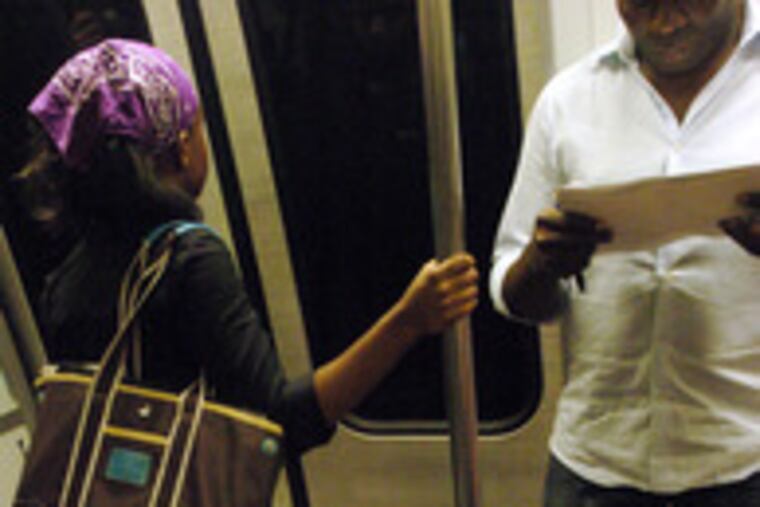Seeing red: D.C.'s Metro faces change
Rather than raise fares, rail will lower ambience.

WASHINGTON - For years, the subway system in the nation's capital prided itself on providing a civilized ride.
With something approaching hauteur, Metrorail looked askance at systems (yo, Philly!) unadorned with its carpeted rail cars, upholstered seats and tasteful, sparse advertising.
That is about to change.
The Washington transit system's new executive plans to rip out the carpets; turn up the illumination in the subdued, grandly vaulted train stations, and plaster nearly every available surface, including station floors, with come-ons for everything from antacids to zinfandel.
Metro general manager John B. Catoe Jr. said he wants service to keep up with growing ridership without incurring deep deficits, a strategy that he says requires the system to trim some costly features that made Metrorail distinctive.
The changes were spurred by a decision earlier this year to not raise fares.
One new feature approved by Catoe already has proved controversial: replacing white warning lights along the platforms that blink when a train is arriving with red ones, which officials said will improve safety.
"Those red lights look like dragon's eyes or the gates of Hell," said Gretchen Jacobs, who as a Justice Department attorney might have seen the latter. "They are just bizarre."
The Washington system, opened 31 years ago, is the nation's second busiest after New York, with a record 208 million riders for the year ending last month. It was the 11th straight year that the 103-mile system recorded an increase in ridership.
Metrorail was conceived as a welcoming, even plush, mode of transport to lure commuters out of their cars. Planned during the Cold War, the soaring arches of the stations aimed to outshine the Moscow subway. The system is generally considered the nation's toniest, along with BART in San Francisco, which is one year older.
Yet with Washington's environs increasingly choked with some of the nation's worst traffic, transit officials are contemplating making the system more plebeian.
Metro hasn't heard much from riders yet, a spokesman said.
"It's pretty new," said Cathy Asato of the Washington Metropolitan Area Transit Authority. "These are just kind of ideas that we're floating."
But down on the platforms the ideas are already taking hold.
"With the exception of the lighting changes, these don't appeal to me," said restaurant manager Robert Hall. "I think Metro needs to find ways to generate more revenue and more effectively use their resources. Quick fixes and cosmetic improvements are not important."
Among more than two dozen riders interviewed, however, the changes generally found favor - with the exception of the advertising blitz.
"I'm torn because they can get more money, but I don't want the advertising in my face every day," said Irene Farrow, who works for an environmental organization.
"I think there's enough advertising - unless they use it to reduce fares," said law-school-bound Whitney Strickland, rolling her eyes at her assumption. "We can dream!"
The massive vaults of the stations are atmospherically lit, to be charitable, but planners did this intentionally.
"They are not supposed to be dark, but brightness is not what the designers were hoping for," said Zachary M. Schrag, author of a history of the Washington subway and a professor at George Mason University in Virginia. "Too much lighting creates shadows, and one of the designers said that brightness and visibility are not the same thing."
Still, anyone who has tried to read the newspaper in the station knows the challenge. "All the stations are too dark, and when I try to read it strains my eyes," said Peter Penn, an engineer.
Kara Franz, a senior at George Washington University, said brighter lighting, which is billed as more energy efficient, would make her feel safer.
"Sometimes I feel nervous about taking Metro late at night," she said.
Perhaps the most aesthetically pleasing feature of the system when it opened was the carpeting in the rail cars, which absorbed noise and made it feel like an airline.
Years of wear have soiled the once-orange carpets, abetted by the thousands of riders - often tourists - who break Metro rules by eating and drinking on the trains.
"I oversee an engineering and a housekeeping department, so I understand the challenge of keeping the carpets clean," said Richard Williams, who works at the Department of Veterans Affairs. "It will be a little noisier, but the trains are packed as it is."
Rick Clark, a flight attendant, said the trains "would probably be more sanitary if they switched from carpet to vinyl."
Dave Kubicek, Metro's new chief of railcar design, said he is exploring various vinyl or tiled alternatives to the carpeting, including non-skid materials and flooring that might help deaden noise. Carpeting is vacuumed weekly, shampooed every two months, and replaced every five years.
Historian Schrag said the carpet "sent a message that this was a nice environment and you were supposed to behave properly."
With vinyl, "you're telling riders visually that this is an environment that's getting hosed down every day," he said. "So it's a possibility people may take advantage of that."